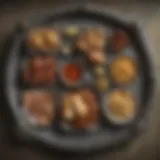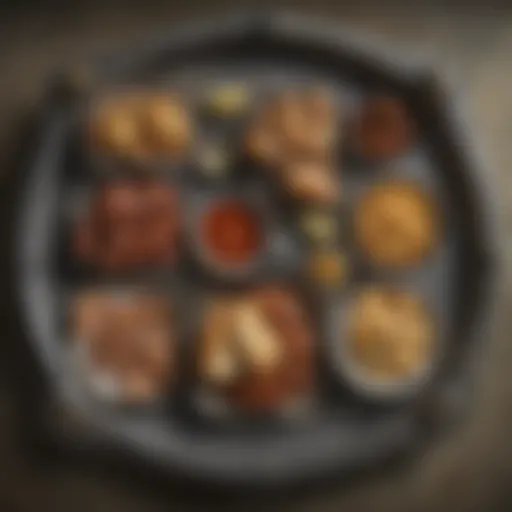Aesthetic and Practical Insights on Floating Spiral Staircases
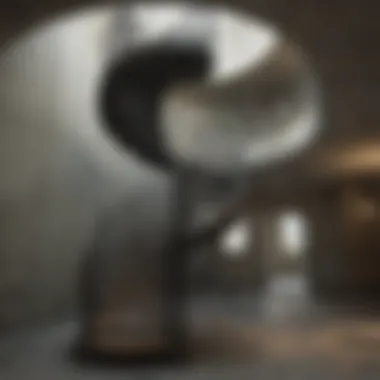

Intro
Floating spiral staircases are a compelling blend of art and utility. Their allure lies not just in their structure but also in their functional elegance. These staircases punctuate the space, becoming vital components of architectural designs where space efficiency is paramount. For those considering such designs, there are both aesthetic benefits and practical challenges involved. This exploration will provide insights into various aspects of floating spiral staircases, guided by architectural innovation and contemporary needs.
Aesthetic Appeal
Floating spiral staircases serve as stunning focal points in both residential and commercial spaces. The seamless appearance brings a modern flair. Unlike traditional staircases, they appear to float, enhancing the visual dynamics of open floor plans.
Key features contributing to their aesthetic appeal include:
- Open Space Integration: Their design promotes an airy feel, avoiding visual clutter.
- Material Diversity: With options ranging from steel to glass, homeowners can tailor their staircase to blend with existing decor.
- Customization: Each spiral staircase can become a work of art, designed to reflect personal style.
These design characteristics make floating spiral staircases an intriguing subject for architects and builders.
Practical Considerations
The practicality of floating spiral staircases necessitates thorough planning and execution. Installation can be demanding because of weight distribution and structural integrity.
Here are practical aspects to consider:
- Load-Bearing Measures: It's crucial to assess if the existing structure can support the staircase throughout usage.
- Human Traffic: The stair's width and design must accommodate the expected foot traffic for safety and convenience.
- Safety Features: Incorporating handrails is often necessary as they ensure compliance with local building codes and provide security for users.
An adept architect or designer can account for these functionalities during the design phase, ensuring both safety and style.
Floating spiral staircases redefine architectural landscapes, benefiting both modern aesthetics and practical use.
Installation Challenges
Installing a floating spiral staircase demands precision. Consideration begins long before one lays the first step. Specific materials present unique challenges.
For instance, wooden staircases typically require heavy-duty supports, unlike lighter steel options that offer some flexibility. It is important to collaborate with experienced contractors for the best outcome. Additionally, chaotic timelines during renovation can hinder the process. Insufficient space during installation might lead to miscalculations in size requirements.
Maintenance Insights
Floating spiral staircases, while captivating, can also encounter wear over time depending on the material.
Some maintenance tips include:
- Routine Inspections: Keep an eye on the joints and support structures to ensure stability.
- Cleaning Solutions: Select appropriate cleaners based on the material to avoid deterioration.
- Re-coating: Certain wood finishes might require refinishing to protect against wear and tear.
Maintaining the charm of these staircases preserves their value both architecture-wise and of real estate.
Epilogue
Overall, floating spiral staircases embody both artistic ingenuity and functional design. By understanding the aesthetic decisions and practicalities involved in their application, one can appreciate their impact on contemporary architecture. For those looking at new designs or renovations, these staircases invite inspiration while serving practical functions.
Foreword to Floating Spiral Staircases
Floating spiral staircases represent a unique category of staircase design that merges aesthetic appeal with functional purpose. They are not just elements of architecture; they embody a statement of modern sophistication. Their streamlined form can complement a variety of architectural styles, promoting open space and enhancing light flow in both residential and commercial frameworks. Therefore, understanding floating spiral staircases is crucial, as they transcend beyond mere means of vertical access; they shape the definition of interior environments in countless ways.
Definition and Characteristics
Floating spiral staircases are characterized by their distinct spiral shape, where the treads are often supported by a central column or are cantilevered from a wall. This structural innovation allows for minimal visual obstruction, offering an illusion of weightlessness. They can be made from various materials, including metal, glass, or wood, which can influence not only their look but also their durability and maintenance requirements.
Another vital characteristic is their adaptability. Floating spiral staircases can fit into diverse interiors, promoting both elegance and efficiency. Their spiral arrangement minimizes the footprint, making them a favorable option for spaces where dimensions are constrained. The right design can create a remarkable focal point that commands attention.
Key Features
- Minimalist Design: The clean lines provide a contemporary living environment.
- Versatility in Materials: Choices affect styling and upkeep; glass offers transparency, while wood brings warmth.
- Space-Saving Structure: Exceptional for limited spaces by offering vertical circulation with a compact footprint.
- Customizable: Allows personalization in various aspects of construction, including height, width, and design aesthetics.
Historical Context
The romance of spiral staircases can be traced to ancient architecture, as seen in medieval castles and cathedrals. They were constructed for both practical and military functions, enabling soldiers to defend upper turrets efficiently. The evolution towards floating designs highlights innovation in material science and engineering techniques, providing not only utility but also visual delight.
Over the centuries, spiral staircases have transformed from utilitarian elements into integral artistic expressions. In contemporary architecture, floating spiral staircases emphasize open space arrangements with enhanced light utilization. This transition matches society's changed priorities, emphasizing the need for both form and function.
The embrace of open concepts and minimalism in recent years has propelled the popularity of floating spiral staircases in urban design, signifying a new era in architectural themes. Recognizing their historical context helps in understanding the perennial allure of these staircases, both structurally and visually.
As a symbol of innovation and creativity in space design, floating spiral staircases embody a merging of art and practicality that extends their influence in modern architecture.
Design Elements of Floating Spiral Staircases
The design elements of floating spiral staircases form a core component in their construction and aesthetic appeal. Focusing on these elements provides insights into how they achieve their unique visual styles and practical applications. Understanding design considerations reflects the overall functionality and influence on both architecture and interior planning.
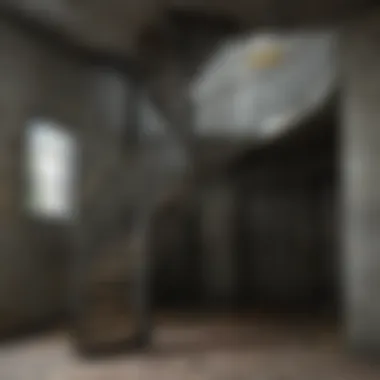

Structural Integrity
Structural integrity is paramount when discussing floating spiral staircases. These staircases rely on core supports and cantilever principles to ensure safety and usability. The central post often acts as the primary support, distributing weight effectively while providing flexibility in design. When improperly designed, these staircases may pose risks, as lack of stability can lead to accidents. Accurate engineering calculations must be made to balance both beauty and functionality.
Furthermore, its lightweight appearance belies significant engineering challenges that must not be overlooked. Ideas like using reinforced steel posts while keeping railings transparent adds to a modern appeal while being efficient. Then careful structural assessment is essencial to ensure long-term reliability and safety. Structurally sound floating spiral staircases harmonize aesthetic views with essential practicality.
Material Selection
Material selection plays an essential role in determining the overall character of floating spiral staircases. The choices impact everything, from durability to overall narrative of space. Multiple materials available each deliver unique properties that suit diverse atmospheres, including but not limited to wood, metal, and glass.
Wood
Wood is a highly versatile timber and a classic choice for floating spiral staircases. One specific aspect includes its warmth and organic appeal, allowing a staircase to blend thoughtfully into living space. The notable characteristic of wood is its ability to be shaped intricately. This makes it a popular choice among designers wanting to experiment with curves and unusual forms.
However, wood can have disadvantages, too. It's potential for expansion or contraction with changing moisture or temperature makes it less predictable than other materials. Also, wood requires regular care to keep it free from wear or damage; neglect can lead to irreversible functional and visual issues.
Besides, there’s an undeniable charm associated with wood that resonates deeply with the users, connecting them to nature and ensuring comfortable, tactile experiences.
Metal
Another material often highlights in the design of floating spiral staircases is metal. Metal has significant strength and is prepared widely for use in staircases due to its unrivaled stability. Key advantages include lower upkeep than wood and a longer lifespan when correctly maintained. Unlike wood, metal can withstand various weather conditions when used externally. Additionally, its sleek surface often, creates an industrious and modern vibe.
However, metal may have certain limitations. It often lacks the warmth associated with wood and can potentially feel too severe in soft, homely environments. If not handled appropriately, sharp or unfinished edges can present safety issues in high-traffic areas. In practical applications, the initial costs for metal staircases can often be higher, due to the details involved in fabrication and assembly.
Glass
Glass stands out in all stairs as ultimate material selections embraced for floating spiral designs. Its translucence allows natural light to maximize and project an airy, open ambiance into a given environment. A vital characteristic is its minimalistic appeal, as it merges modern aesthetics with strength. Its relatively simple clean lines might suit contemporary architectures terribly well.
Yet, glass too, has its disadvantages. Awareness needs to be undrerstood regarding the weight it brings and the required strong framing to support safely its thermal and mechanical weaknesses. It can thus necessitate a masters touch with mullions being required to stabilize midpoints to prevent unwanted movement. Moreover, glass needs regular cleaning to maintain its clear appearance, which must always be considered when choosing the material.
Answering into considerations of wood, metal, and glass, a careful selection fashioned with a purpose enables one to converge practical potential with distinctive presence. Key insights into these materials help in embracing their unique potential while recognizing necessary compromises when deciding to use them in floating spiral staircases.
Functional Aspects
Exploring the functional aspects of floating spiral staircases is vital in understanding their utility in modern architecture. This section examines two crucial elements: space efficiency and accessibility concerns. Each of these elements contributes to the thoughtful integration of floating spiral staircases in various environments, highlighting not just their dynamic forms, but also their practical applications.
Space Efficiency
Floating spiral staircases are known for maximizing available space. Their design allows them to occupy a minimum footprint compared to traditional stair formats. This is especially beneficial in urban environments where square footage comes at a premium. The twist of the stairs provides vertical access while promoting the illusion of openness.
In open-plan areas, a floating spiral staircase can act as a sculptural piece, drawing the eye upward without hindering sight lines across the space. This is a significant consideration in modern design, where visual connectivity between different levels adds to the overall aesthetic. Because of their design, this type of staircase can be installed in corners or tight spots, transforming previously underutilized areas into functional parts of the building.
Moreover, the efficient use of vertical space allows for additional features like storage areas underneath the staircase. This not only enhances the functionality of an area but also promotes an organized environment. Assigning multifunctional tasks to architectural elements like staircases is a trend that is becoming increasingly popular.
Accessibility Concerns
While floating spiral staircases provide unique benefits in space-limited designs, their accessibility warrants careful consideration. The helical shape poses immediate challenges for those who may have mobility issues. This exclusivity might deter their use in residential environments or public spaces.
This design also concerns compliance with safety building codes and accessibility regulations. For staircases to be accessible, they often must adhere to specified widths and inclinations. Building codes might mandate additional handrails, increased landings, or specific tread and riser dimensions to ensure user safety and accessibility. For proponents of fine design, these modifications may represent a compromise between aesthetic appeal and practical functionality. Therefore, while evaluating the functionality of floating spiral staircases, one must balance design ingenuity with usability in mind. Ensuring all users can navigate these innovative fixtures starts by recognizing their limitations in order to address them effectively, resulting in a design that is both beautiful and functional.
Aesthetic Considerations
The aesthetic considerations for floating spiral staircases are paramount in understanding their burgeoning popularity in modern architecture. These staircases are not merely functional; they are works of art. The visual appeal they offer can transform a mundane space into a visually striking area. Their design can evoke elegance and sophistication, making them a focal point in any setting.
Visual Impact
The visual impact of floating spiral staircases often lies in their ability to blend utility with beauty. This unique attribute sets them apart from conventional staircases. When designed effectively, they provide an artistic touch qualified by an illusion of lightness. This design trait can dramatically alter perceptions of physical space.
Several factors contribute to this visual appeal:
- Curvilinear Geometry: The flowing lines can create a sense of motion and harmony.
- Open Design: By excluding traditional support structures, they offer a sense of spaciousness, making areas feel less confined.
- Material Variety: Different materials can enhance the overall visual aspect. For instance, utilizing glass or metal can add sleekness, while wood brings warmth and texture.
In residential homes, floating spiral staircases enhance the overall decor. They can be designed in a way that visually interacts with light, enhancing a room's atmosphere. For commercial spaces, these staircases directly influence the brand identity of businesses since their design remains memorable and recognizable.
Integration with Interior Design
The integration with interior design is essential when discussing floating spiral staircases. Their aesthetic requires a thoughtful approach to ensure coherence with the surrounding elements. This attention to detail enhances not only the staircase itself but the entirety of the room.
Here are some considerations for effective integration:
- Matching Materials: Ensuring the staircase materials correspond with other elements in the room helps create unity. For instance, a wooden staircase can beautifully complement wooden doors or furniture.
- Color Coordination: Keeping a consistent color palette among the interior items can help in achieving harmonious visual transitions.
- Placement: The location of the staircase is often crucial. A strategically placed staircase may serve as a percentage of décor, guiding the natural flow within the room and accentuating specific artworks or architectural features.
Installation Challenges
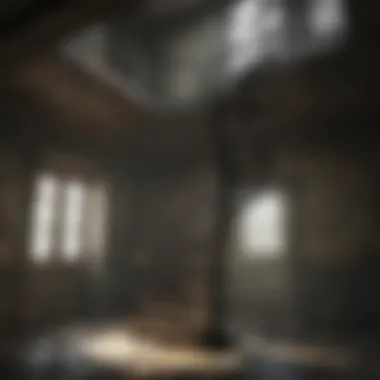

The installation of floating spiral staircases presents unique challenges that require careful consideration. Understanding these challenges is crucial for ensuring the overall stability, safety, and aesthetic appeal of this architectural feature. Addressing installation challenges can enhance not only the functionality but also the integration within existing spaces.
Site Preparation
Site preparation is one of the key elements in the installation of floating spiral staircases. This phase involves assessing the area where the staircase will be installed. Factors such as floor type, structural stability, and surrounding wall configurations must be meticulously analyzed. It is essential to ensure that the floor can support the weight of the staircase and that proper anchoring points are established.
Tools measuring exact distances are vital during this stage. Ensuring proper height and diameter estimations will influence not only usability but also the stair’s overall aesthetic. If the site is not adequately prepared, it can lead to complications that will affect the staircase longevity.
It is crucial to involve qualified professionals during the site preparation phase to account for any potential structural uncertainties.
Additionally, environmental considerations, such as humidity and temperature, play a role in material choice and durability. For example, wooden elements may react adversely in overly humid conditions. Therefore, adequate preparation helps mitigate future issues and ensures a seamless installation process.
Safety Regulations
Compliance with safety regulations is imperative when embedding floating spiral staircases in buildings. Each country and region may have specific mandates that must be satisfied. Regulations often cover load limits, tread design, and handrail requirements. Non-compliance can result in legal repercussions and dangerous environments, undermining the intended beauty of the staircase.
Installing floating spiral staircases necessitates an understanding of the relevant modern building codes. Architect and contractor collaboration is non-negotiable to guarantee every requirement is met from project conception through completion. Creating a comprehensive plan that incorporates these regulations ensures safety without compromising design.
Incorporating elements like a skid-resistant surface and sufficient handrails can significantly enhance user safety. Additionally, the installation crew should possess knowledge about any local differences that might impact the staircase design or its installation.
In summary, navigating installation challenges associated with floating spiral staircases involves a detailed focus on site preparation and compliance with safety regulations. These aspects are paramount for harmonious integration within the structure while prioritizing both practicality and aesthetics. Ensuring these areas are handled satisfactorily not only enhances the functionality but also fortifies lasting appeal.
Maintenance and Durability
Understanding the maintenance and durability of floating spiral staircases is essential. These architectural features are not only appealing but also functional. Regular upkeep ensures that they remain safe and aesthetically pleasing. Neglect can lead to a decline in both condition and value.
Routine Care
Routine care involves performing regular inspections and cleaning. Inspect staircases for any signs of wear and tear. This might include checking for loose steps, considering materials used, and monitoring any signs off rust or water damage, especially for metal or wooden structures. Such damage, if left unchecked, can escalate over time.
Adequate cleaning requires a gentle approach. Usual products include neutral pH cleaners mixed with water. There’s no need for harsh chemicals that can actually harm the materials. Frequent dusting and mopping will prevent dirt build-up and preserve the visual aesthetics. Environment contributes significantly; a humid area requires more frequent checks.
“Protecting the elegance entails preserving the quality.”
Longevity Factors
Several factors influence the longevity of floating spiral staircases. First and foremost is material choice. Aluminum and stainless steel are renowned for their strength and resistance to corrosion. These metals can endure the elements with minimal issues. Conversely, wood can give charm but may require more maintenance to ensure longevity.
Another critical aspect is the environment. Exposure to harsh weather, especially for outdoor staircases, can affect their lifespan. Positioning is also important. If the staircase is used heavily, such as in commercial spaces, those too will likely undergo more wear compared to those in residential areas.
It is wise to contemplate initial design for optimal longevity. Properly designed staircases will have considerations for weight distribution, ensuring that stress points are feasible. A competent installation firm can deliver the necessary quality. Choosing seasoned professionals can considerably enhance the staircase's lifespan.
Floating Spiral Staircase in Modern Architecture
The incorporation of floating spiral staircases into modern architecture represents a blend of artistry and functionality. These structures enhance spatial dynamics, often becoming striking focal points within an interior. As architects seek ways to make use of vertical spaces innovatively, floating spiral staircases provide both aesthetic and practical solutions. They challenge traditional norms and embody the pursuit of creating environments that are as beautiful as they are functional.
Case Studies
Examining case studies of floating spiral staircases reveals their diverse applications across various architectural styles. For example, the renowned residential home by the architect Zaha Hadid features a floating spiral staircase that seamlessly integrates with its organic forms. The staircase is not only a means of circulation but also enhances the overall visual experience of the space.
Another notable case is the Apple Store in Milan. Inside the store, a stunning glass-floated spiral staircase draws the eye. It serves an important purpose, allowing customers to ascend to a hidden upper floor while showcasing modern engineering finesse. Such installations illuminate the bridge between art and engineering in contemporary designs.
Influence on Contemporary Design Trends
Floating spiral staircases significantly influence trends in modern design. They call for a reevaluation of how stairs fit into spaces, encouraging greater balance between open floor plans and verticality. These staircases harmonize functionality while distinguishing themselves through minimalist aesthetic.
Many architects are exploring unconventional materials such as glass, creating light and transparent structures. The trend is shifting towards less obtrusive designs that seem to float gracefully in mid-air. This change not only enhances the visual appeal but also emphasizes architectural brilliance and fluidity.
Considering a floating spiral staircase is not merely about zeroing in on style but engaging with methodology and purpose for today.
Overall, today's design trends embrace a combination of sustainability and innovation. Floating spiral staircases represent this movement, showcasing how functionality does not need to sacrifice beauty. By analyzing their placement within larger architectural narratives, it is evident they continue to forge their path in the future of modern structure.
Comparative Analysis with Traditional Staircases
The exploration of floating spiral staircases gains new dimensions when compared with traditional counterparts. This comparative analysis underscores crucial elements such as design versatility, construction implementation, and overall aesthetic contribution to space. Understanding these differences is essential for industry professionals and enthusiasts keen on leveraging sophisticated designs while ensuring functionality.
Design Differences
Floating spiral staircases typically boast a unique visual presentation compared to traditional ones. While standard staircases often rely on full banisters and bulky support structures, floating spirals rely on fewer designs elements to achieve an airy appearance. The design showcases sleek lines and an open substructure that minimizes visual noise in any given area.
Notably, traditional staircases often feature heavy materials like wood or concrete that add weight and solidity through their obvious structure. In contrast, floating spiral staircases embrace lighter materials that enhance the illusion of hovering. This aspect not only provides a modern flair but integrates seamlessly into contemporary spaces, where aesthetics and functionality are vital.
Space Utilization
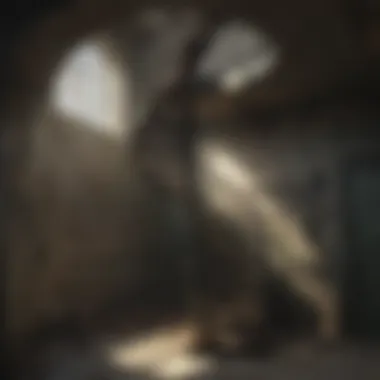

When considering space, floating spiral staircases effectively maximize available areas with efficient placements. Their compact and helical form takes considerably less room than conventional staircases. This is particularly important in urban settings, where floor space is a luxury.
• Vertical Space Enhancement: These staircases preserve significant floor space by extending vertically. Traditional designs may require adjacent areas for width expansion, whereas floating stairs spiral up without the need for wide landings.
• Multi-functionality: The open spaces beneath using floating designs can adopt other functions, serving maybe as a storage area or integrating seating or decor.
• Diverse Styles and Fits: This versatility in design fits various architectural idioms while allowing specific personal tastes. The uses of sleek materials like glass for visibility only heighten spaces verses heavy traditional descent.
In summary, the insightful differences elucidated in this analysis demonstrate the practicality and aesthetics of floating spiral staircases. Recognizing their inherent benefits over traditional stair builds empowers better design choices throughout various projects.
Cost Considerations
Cost considerations in the context of floating spiral staircases are crucial for both homeowners and architects. Of utmost importance are the initial investment, material costs, and long-term maintenance expenses. This section aims to illuminate the financial implications associated with the installation and upkeep of these unique structures. Understanding these factors is vital for making informed decisions that balance aesthetic appeal with budgetary constraints.
Budgeting for Installation
Undertaking a project involving a floating spiral staircase requires careful budgeting. The first step in this process is to outline all potential expanses. This includes the selection of materials, labour costs, and complexities of installation. High-quality materials such as glass or metal can substantially raise costs compared to wood. Structural engineers may also be necessary, contributing to additional fees.
- Here are key components to consider when budgeting for installation:
- Material Choice: Cost varies significantly between wood, metal, and glass. Choose based on both aesthetics and durability.
- Labour Costs: Skilled workers may be essential for installation. Always account for hourly rates and overall experience level.
- Site Preparation: Proper groundwork is needed to accommodate these staircases, which may necessitate further costs.
It’s essential to create a realistic budget that encompasses all these factors upfront to avoid unexpected expenses later.
Value vs.
Investment
When considering a floating spiral staircase, it is also important to weigh its value against the investment required. These structures provide immense value in terms of design uniqueness and contributing to home resale value. Floating spiral staircases can elevate the entire aesthetic of a home, thus justifying their cost. Architects often note that they can be a selling point in the real estate market, enhancing a property's appeal to buyers looking for contemporary designs.
Factors to evaluate when analyzing value versus investment include:
- Aesthetic Impact: The visual enhancement can increase overall satisfaction. For many, beauty has no price.
- Long-term Durability: Investing in quality materials often leads to lower maintenance costs and longer lifecycle, ultimately saving money over time.
- Market Trends: Floating staircases link with modern design trends, potentially increasing a property's marketability.
Understanding the balance between the cost of a floating spiral staircase and its intrinsic value can lead to thoughtful home design choices that are both practical and stylish.
Future Trends in Stair Design
The realm of modern architecture continuously evolves, and stair design stands as a vivid example. Floating spiral staircases, with their captivating aesthetic and efficient use of space, are set to play a significant role in future designs. This section delves into the relevance of emerging trends in stair design, exploring sustainability in materials and innovative concepts that push boundaries.
Sustainability in Materials
The increasing emphasis on sustainability shapes future stair design profoundly. Architects and designers are leaning towards materials that exhibit eco-friendly characteristics. This shift encompasses recycled, renewable, and biodegradable materials. Using products like reclaimed wood or recycled metal not only helps reduce waste but also lowers the environmental impact associated with production.
Sustainable materials are beneficial in terms of
- Durability: Eco-friendly materials often have enhanced durability, requiring less frequent replacement.
- Energy Efficiency: Employing energy-efficient practices during manufacture contributes to an overall reduction in carbon footprint.
- Aesthetic Appeal: These materials can maintain artistry and elegance, supporting the visual integrity of floating stairs.
This holistic approach to material use transforms staircases from mere functional structures to elements of environmentally conscious design.
Innovative Design Concepts
Innovation is key in redefining floating spiral design perspectives. Emerging technologies and materials pave the way for creative concepts that underscore not only form but function. These trends show how designers incorporate new ideas into floating staircases while changing their appearance, usability, and alignment with modern lifestyles.
- 3D Printing: This technology offers new possibilities for designing intricate and unique staircase structures that were once challenging to create.
- Modular Designs: They allow for customizations and easy scalability, fitting various interiors and functional needs.
- Smart Technology: Integrated systems can offer lighting solutions based on user preferences or even adjustable features that adapt the staircase to the space efficiently.
Floating spiral staircases will see integration with smart home technology, making functionality pivotal, alongside aesthetic. This complexity ensures that each staircase compliments the surroundings beautifully without sacrificing its purpose.
The future of stair design lies in merging artistry with functionality and sustainability—laying the foundation for stunning solutions that reflect today’s needs and tomorrow's aspirations.
Ending and Final Thoughts
In concluding this discussion on floating spiral staircases, it becomes evident that their significance extends beyond mere aesthetics. These staircases represent a remarkable intersection of form and function in architectural design. They serve not only as a means of vertical movement within a space but also as a distinct design element that can influence the entire ambiance of a home or commercial environment.
Addressing the key aspects of floating spiral staircases reveals several pivotal benefits: * they maximize space efficiency, * enhance spatial flow, * and contribute to an entity's overall appeal. The design choices regarding materials greatly affect both the stair's durability and aesthetic. Moreover, sustainability considerations are rising in relevance, making the selection of eco-friendly materials particularly important in contemporary architecture.
Further, we have explored significant challenges that can arise during the installation and maintenance of these structures. Such challenges demand thorough planning and exact preparation to ensure safety and sturdiness throughout their life span. Proper care and an understanding of longevity factors play crucial roles in maintaining the integrity of floating spiral staircases.
Ultimately, the study of floating spiral staircases addresses profound implications for future design trends. By analyzing these staircases through both a functional and aesthetic lens, designs can advance and evolve in innovative ways tailored to new lifestyle norms.
Summation of Key Points
- Floating spiral staircases blend aesthetic appeal with practical functionality.
- They help maximize small spaces while providing a striking visual element to interior environments.
- Material choice plays a crucial role in the longevity and sustainability of these staircases.
- Installation challenges are significant but may be confronted with appropriate guidelines and preparation.
- Understanding maintenance protocols can assist in prolonging the life of floating spiral staircases.
Implications for Future Design
The implications addressed in this article unfurl diverse considerations essential for future design trajectories. Architects and designers are now urged to respect not only functional requirements but also the potential that floating spiral staircases can bring to sustainable practices in architecture. As buildings aim to integrate more natural elements and efficient space usage, these staircases can provide optimal solutions without losing aesthetic value. Furthermore, as society leans towards sustainability, the emphasis on innovative materials, including recycled and environmentally friendly ones, is expected to shape future designs. By adopting such practices within floating stair concepts, architects align with forward-thinking approaches that reflect contemporary values and move the field towards broader accessibility and inclusiveness.
"In architecture, every detail should tell a story, every component should enhance the narrative, which floating spiral staircases exemplify beautifully."
